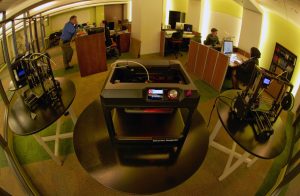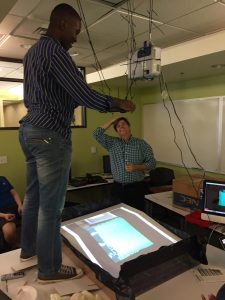(Originally Published on nmc.org March 2016)
In “Teaching Creativity – Not Conformity,” I began by positing that we need to encourage exploration through questioning rather than providing answers to our students (and employees). Since then, Kevin Kelly has reemphasized the same theme by identifying the skill of questioning as one of the key trends that will shape humans in our technological future. We have been talking this talk for years now. The exciting thing is that technology is now giving us tools to start walking the walk.
In an age driven by “quantifiable” accountability, however, many of our present organizations continue to struggle with the concept of open-ended outcomes. If we stress a questioning approach, particularly in a programmatic context, it is often seen as a risk that is hard to quantify unless we provide some sort of predictable, often quantified, outcome. Uncertainty of outcomes is often viewed as not being scientific or data-driven. That is only true if we are looking for overly simplistic answers in defining success. We can still measure outcomes – but they are often tangential to the original creative exercise. Sounds a lot like teaching, does it not?[LINK: http://www.nmc.org/blog/teaching-creativity-not-conformity/]
In 2010, I began facilitating the New Media Seminar for faculty at HCC’s Northwest College, which focuses on how the world is changing and ways in which we as educators need to adapt to those changes. Initially, I was attracted to the concept developed by Gardner Campbell because I felt it provided a nice venue for free discussion about technology and the development of pedagogy. What I did not realize at the time was the extent to which it developed questioning about the status quo of what we are doing in the classroom. Many faculty members who have participated in the seminar found it a strangely liberating experience from their daily experience precisely because of its open-ended nature. It was always a challenge, however, to explain that power to those looking at the course from the outside.
I am often surprised at how unwilling people are to question the seemingly predictable flow of their existence in order to leave room for the unexpected outcome. I always start my undergraduate government classes asking my students why they are there. It amazes me how few of them have even pondered the question. A lack of purpose turns college into essentially a hazing experience whose main purpose is to demonstrate perseverance, not learning, and all too often faculty aid and abet that by passing them through classes without giving them a clear reason to engage in learning. Furthermore, as we design courses and programs it is often easier to just go with the flow rather than risk the unexpected or ambiguous. Like training, answers give us neat little boxes in which to put everything. Teaching has the power to augment us as human beings. Giving students and faculty the freedom to creatively explore without a set purpose is liberating to some, incomprehensible to some, and threatening to others.
Makerspaces perhaps pose the biggest threat to the status quo: if they live up to the true ideals of making, outcomes are truly uncertain. In January 2016 we opened the D-Lab, the first of our makerspaces at Northwest College. The critical aspect that characterizes our D-Lab is that it is essentially a “rule-free” zone designed to promote creative problem solving. Questioning is driving the very development of the space, as we have added and adapted equipment and supplies based on community inquiries. Many of our spaces are being designed around the concept of project-based learning and our new building, the West Houston Institute, was explicitly designed to foster innovation and creative thinking. [LINKhttp://ideaspaces.net] The goal is to lower the barriers to entry as much as possible and then get out of the way.

The D-Lab – Photo by Tom Haymes
We also recognize that all of these plans will falter if we cannot work to move HCC’s culture away from the rigidity that characterizes industrial modes of education. Training is a natural outcome of this kind of thinking. The D-Lab forms a gateway to a post-industrial mode that nurtures creative thought that is liberated by good teaching. To be clear, this is a hard task that will take years to manifest any appreciable impact institution-wide. Meanwhile, we are already seeing people gravitate to the freedom of the D-Lab in unexpected and unconventional ways.
Recently, my lab techs decided to build a virtual sandtable using an old projector and an Xbox Connect. They improvised this rig using zip ties and rubber bands. Believing it looked unsafe, our AV contractor offered to provide a proper mounting solution (costing hundreds, if not thousands, of dollars and taking months to implement, no doubt). I don’t blame him. He’s never seen activity like this at our college before. The space is generating a new form of agile activity not previously seen at our college.

Virtual Sand Table in the D-Lab – Photo by Tom Haymes
The D-Lab has shown me that there is a genuine hunger for independent thought and the creativeenterprise. Technology merely provides the mechanism to escape the rigid structures of the industrial world. This creativehunger is precisely what we need to harness bothinternally and for our students if we want to be successful in a world characterized by automation and increasingly complex problems. We are all creative teachers and learners. We just need to have that unlocked. I am seeing that happen every day in spaces like the D-Lab. It gives me hope that we will finally move away from the training mode to the creativemode.
We are currently in the process of developing business plans for the programs we envision at our new building, the West Houston Institute. Unlike the New Media Seminar, which cost relatively little other than time, and the D-Lab, which came together out of spare project funds, the Institute is a $50 million project before staffing costs. With scale comes scrutiny and a search for clarity by decision makers. While this approach is completely understandableand a responsible use of taxpayer money, a space designed around open-ended inquiry and uncertain, creative outcomes often challenges this kind of thinking.
It is relatively easy to figure out a hard set of numbers around a Collaboratoriumor conference space that can be rented out to business. At the same time, it is more difficult to demonstrate concrete outcomes around how these kinds of spaces also foster open-ended activities such as brainstorming projects and technology competitions. Activities in the makerspace or informal collaboration areas face similar challenges. If they are not associated with a particular program, it can be difficult for people to wrap their heads around the spaces’ purpose. Is the idea to let people play around? To what end? Quantifying qualitative outcomes is one of the central challenges of educational measurement and it is particularly acute in these kinds of circumstances.
The best argument to make is that this creates a very compelling learning environment, is a fun way to teach, and, perhaps most of all, creates critical 21stCentury skillsets in our students (and faculty). This approach fits into of the overall trend of refocusing around demonstrating skills rather than credentialing that is starting to be discussed throughout education.
One of my pet projects, the Teaching Innovation Lab (TIL) [LINK: http://ideaspaces.net/2016-innovation-loops-ideaspaces-presentation], addresses this challenge as well. The purpose of the TIL is to build upon the success of the New Media Seminar to create an open-ended venue for faculty to “play” with their teaching and share those experiences with their colleagues both inside and outside HCC. We also introduce rigor through data collection and analysis as well as structured workshops and other activities. Where faculty take it from there is up to them, however. Unlike many professional development projects, there is no defined fixed outcome. If it makes things better, it is a win.
I am excited about the potential for creative unpredictability of all of these efforts, but I can see where it runs counter to desires to establish standards around “good teaching” by accrediting agencies and state education boards. I do not believe there is one “right” way to teach, or at least I do not believe we are anywhere close to understanding what that is yet. Putting that notion into a business plan for the TIL is therefore presenting unique challenges. Some flexible thinking will be required all around. It is difficult to imagine quantifying exploration and unexpected outcomes. We can build a runway, but where flight takes our faculty and students is their magic, not ours. In other words, we can measure results in the context of skills acquired, but not necessarily predict them. That sounds amazingly like teaching to me.


